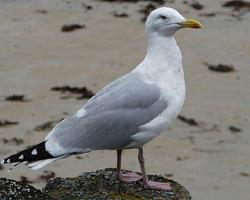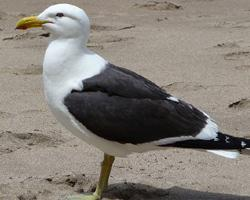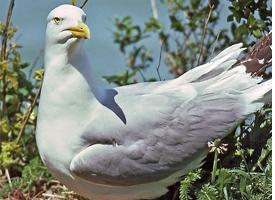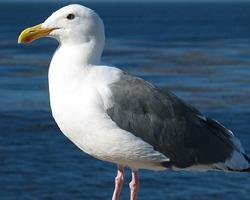
Stav ohrožení
| Ohrožen |
Popis zvířete
The European Herring Gull (Larus argentatus) is a large species of seabird belonging to the gull family Laridae. This bird is native to much of Europe, parts of Asia, and the north Atlantic coast of North America. It is one of the best-known of all gulls along the shores of western Europe, recognized for its size, robust build, and distinctive markings.Adult European Herring Gulls have a striking appearance, with a body length ranging from 55 to 67 centimeters (22 to 26 inches) and a wingspan that can reach up to 150 centimeters (59 inches). They possess a hefty build with a deep chest, long wings, and a robust, slightly hooked bill that is yellow with a red spot on the lower mandible. The bird's head, tail, and underparts are predominantly white, while the back and the upper wings are a light grey. The wingtips are black with white spots known as "mirrors" due to their reflective quality. Their legs and feet are pink, and they have pale yellow to yellowish-green eyes surrounded by a thin, red orbital ring.
Juvenile European Herring Gulls undergo a complex moulting process, taking four years to achieve their adult plumage. In their first year, they exhibit a mottled brown appearance, gradually acquiring more white and grey feathers in subsequent years until they reach the full adult coloration. This prolonged maturation process makes them one of the more fascinating gulls to study for bird watchers and ornithologists, offering a range of plumage patterns based on the age of the bird.
The European Herring Gull is a versatile feeder, which contributes to its success in various environments. Its diet includes fish, insects, worms, small birds, and mammals, as well as carrion and garbage. This adaptability in feeding habits allows it to thrive not only in coastal regions but also in urban and suburban areas where food sources are plentiful. The bird is known for its intelligence and resourcefulness, employing various techniques to access food, including dropping shellfish from heights to break them open.
Breeding typically occurs in colonies that can be found on cliffs, islands, or even in urban areas, with nests constructed from grass, seaweed, and twigs. The European Herring Gull is monogamous, with pairs often remaining together for many years. Females lay two to four eggs, which are incubated by both parents for about a month. The chicks are precocial, born with their eyes open and covered in down, ready to leave the nest within hours of hatching, though they remain dependent on their parents for food and protection for several weeks thereafter.
Despite their widespread presence, European Herring Gull populations have faced declines in some areas due to factors such as habitat loss, pollution, and changes in food availability. They are currently classified as Least Concern by the International Union for Conservation of Nature (IUCN), but conservation efforts are ongoing to ensure that this iconic species can continue to thrive in its natural habitats as well as in the urban environments it has so successfully adapted to.
In summary, the European Herring Gull is a complex and fascinating bird, emblematic of coastal regions but highly adaptable to a range of environments. Its distinctive appearance, intriguing life cycle, and remarkable adaptability make it a subject of interest not only for bird enthusiasts but also for those interested in the broader themes of adaptation and survival in the animal kingdom.
Podobná zvířata
Nové fotografie zvířat
Top 10 zvířat
- Common cockchafer (Melolontha melolontha)
- Common house mosquito (Culex pipiens)
- Colossal squid (Mesonychoteuthis hamiltoni)
- Giant house spider (Eratigena atrica)
- Harpy eagle (Harpia harpyja)
- Fruit fly (Drosophila melanogaster)
- Common reed warbler (Acrocephalus scirpaceus)
- Australian box jelly (Chironex fleckeri)
- Proboscis monkey (Nasalis larvatus)
- Moustached guenon (Cercopithecus cephus)


